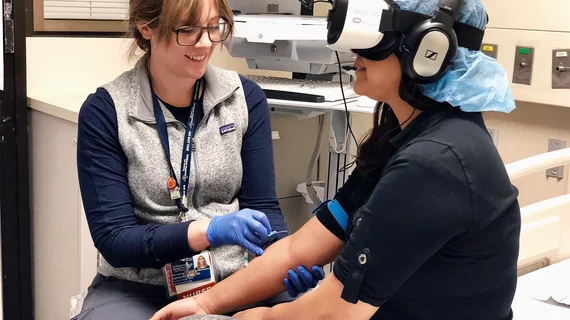Using virtual reality has helped one radiology department significantly reduce patients’ pain and anxiety tied to peripheral IV catheter placement, according to research published Wednesday in JAMA Network Open.
Children can experience considerable discomfort and distress during the insertion of these devices, used for administering contrast agents, among other things. However, Children’s Hospital Los Angeles has found early success using a multisensory VR game to help calm kids during their imaging encounter.
Lead author Jeffrey Gold, PhD, and colleagues see promise using this technology in other aspects of radiology and beyond.
“Virtual reality, a nonpharmacological intervention, is an empirically supported, feasible, and cost-effective solution to managing pain and anxiety during routine venipuncture procedures in the pediatric setting,” Gold, with USC Keck School of Medicine’s Department of Anesthesiology, and co-authors wrote Aug. 25. “Future research on reducing pain and anxiety during medical procedures (e.g., magnetic resonance imaging, [peripheral IV catheter] placement, lumbar puncture, otolaryngologic procedures, and cast removal) may benefit from examining interventions that reduce or eliminate the use of medications,” they added later.
Children’s conducted a randomized clinical trial from 2017-2019 to test out its virtual reality intervention. Researchers incorporated 107 patients (ages 10-21) undergoing peripheral IV catheter placement at either the health system’s department of radiology and imaging, or the infusion clinic. Patients, their caregivers and providers all completed pre- and post-treatment questionnaires to help gauge pain and anxiety.
Subjects were randomly assigned to use either the VR tool or numbing cream alongside standard distraction techniques such as music, coloring, singing and talking. The former involves wearing a headset and engaging their eyes and ears, traveling a preset path through a colorful, interactive 3D environment filled with animated landscapes. Users’ vision helps control the direction of a cannon, fired to knock over virtual teddy bears.
Subjects averaged an age of about 15 and almost 60% were male. VR users and clinicians reported much lower mean post-PIVC anxiety scores, along with significantly lower pain scores following the IV insertion. No demographic variables among the virtual reality group were associated with lower levels of post-PIVC pain and anxiety.
Those involved said they see VR’s role growing further in radiology. Gold said he hopes to launch a new study tied to MRI prep, using the goggles for training, along with decreasing stress, anxiety and claustrophobia. His hope is to drop the need for sedation while bolstering the number of successful scans free from artifact.

